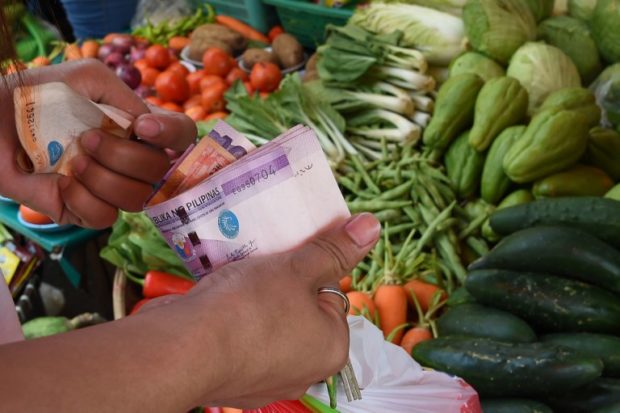
A customer buys vegetables at a market in Manila. (Photo by TED ALJIBE / AFP)
MANILA, Philippines — Despite the lower-than-expected October inflation rate, the prices of basic goods and services will continue to experience upward pressure as the holiday season approaches, the Bangko Sentral ng Pilipinas (BSP) said on Friday.
The central bank made the assessment after the Philippine Statistics Authority (PSA) announced on Friday that the October 2021 inflation fell to 4.6 percent from the previous month’s 4.9 percent.
This was within the BSP’s forecast range of 4.5 to 5.3 percent and the BSP expects inflation to average above the target range of 2 percent to 4 percent this year, but the central bank also expects prices to ease to the midpoint of that same target range over the next two years.
“The balance of risks to the inflation outlook remains on the upside for the remaining months of 2021, but continues to be broadly balanced for 2022 and 2023,” BSP Gov. Benjamin Diokno said in a statement.
Diokno maintains that “supply-side price pressures are best addressed by timely nonmonetary policy interventions” and the central bank was “ready to maintain its accommodative monetary policy stance.”
Supply-side interventions
He said the BSP was also reviewing the price environment ahead of the next monetary policy meeting on Nov. 18.
Headline inflation during the first 10 months averaged 4.5 percent, staying above the 2- to 4-percent target range that the BSP saw as “manageable.”
The latest PSA data showed that average consumer prices in October were 0.9 percent higher than September levels.
But National Statistician Dennis Mapa said at a press briefing on Friday that price increases in food and nonalcoholic beverages slowed to 5.3 percent last month from 6.2 percent in September.
Meat inflation declined to 11.9 percent from 15.6 percent as pork imports augmented the supply shortage caused by the African swine fever (ASF) outbreak.
Mapa said the price of pork meat with bones declined to P282 per kilo from P295 a month ago in Metro Manila. It also fell to P254 a kilo last month from P282 on average in September outside Metro Manila.
“One of the government’s highest priorities amid the mobility restrictions is to ensure stable access to affordable food,” said Socioeconomic Planning Secretary Karl Kendrick Chua, head of the National Economic and Development Authority.
The latest data, said Miguel Chanco, senior Asia economist of Pantheon Macroeconomics, showed that the government’s supply-side interventions were bearing fruit.
But prices of petroleum and fuels surged 32.9 percent year-on-year, a faster pace than the 21.3-percent hike in September, as high global oil prices spilled over to local pump prices.
“The slowdown in food inflation continued to mask the pass-through of oil price pressures … The lagged impact of the gains in global oil prices … suggests that housing and utilities inflation could go as high as 7 percent in the coming months, while transport inflation could easily double in the short run,” Chanco said.